MITS5502: Developing Enterprise Systems Research Report, July 2019
VerifiedAdded on 2022/11/29
|10
|2228
|53
Report
AI Summary
This research report delves into the complexities of Developing Enterprise Systems, focusing on Enterprise Architecture Management (EAM). The report analyzes the challenges and benefits of implementing EAM within business organizations, highlighting the importance of aligning IT strategies with business processes. It discusses various research streams, including the implementation of EAM models, processes, and governance. The report also explores the critical need for stakeholder orientation and addresses the existing gaps in organizational implementation procedures. The conclusion emphasizes the advantages of EAM and the need for organizations to consider key factors for successful implementation. The report also references a range of academic sources, providing a comprehensive overview of the subject matter.
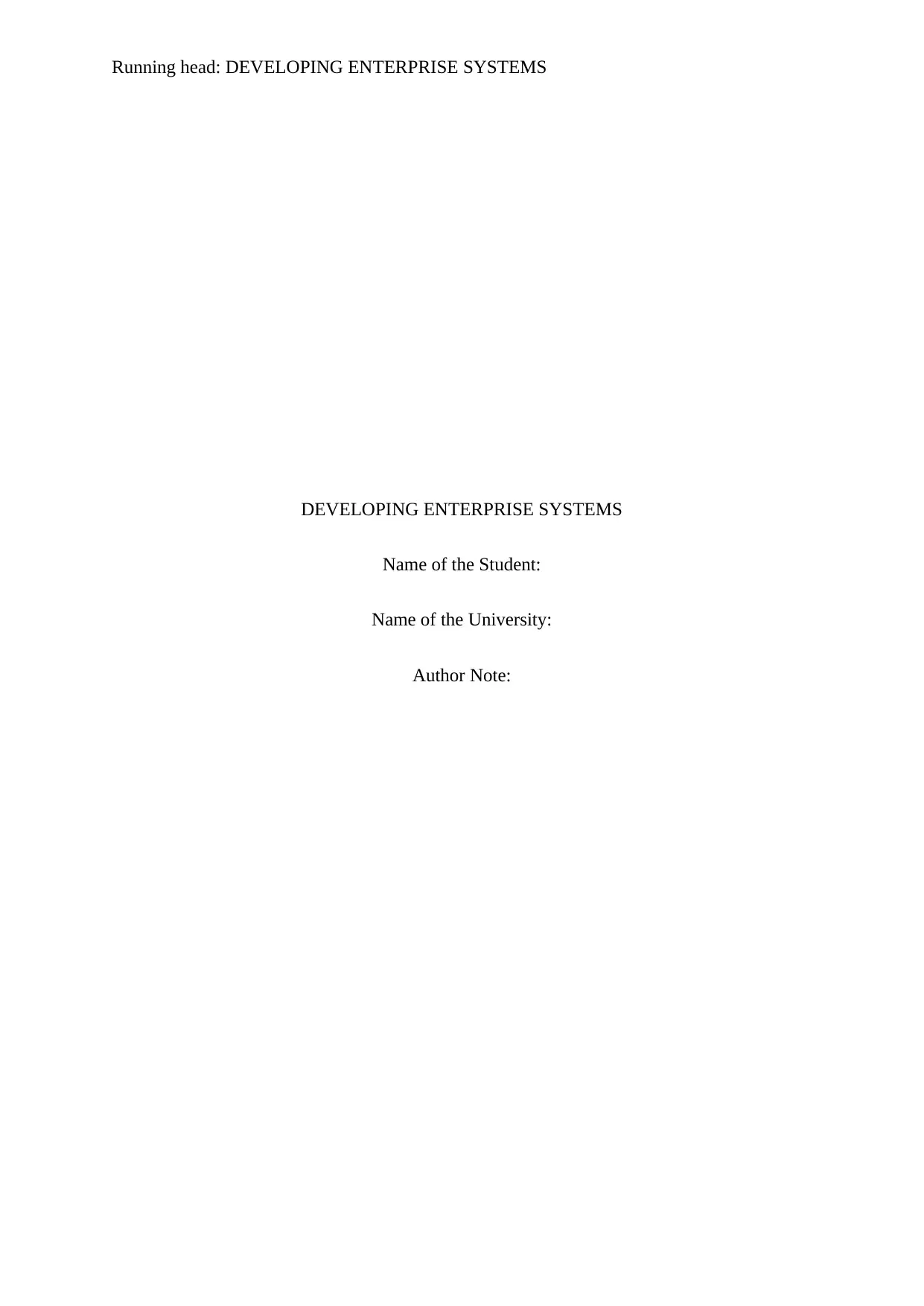
Running head: DEVELOPING ENTERPRISE SYSTEMS
DEVELOPING ENTERPRISE SYSTEMS
Name of the Student:
Name of the University:
Author Note:
DEVELOPING ENTERPRISE SYSTEMS
Name of the Student:
Name of the University:
Author Note:
Paraphrase This Document
Need a fresh take? Get an instant paraphrase of this document with our AI Paraphraser

1
DEVELOPING ENTERPRISE SYSTEMS
Table of Contents
Introduction................................................................................................................................2
Discussion of the research..........................................................................................................2
Conclusion..................................................................................................................................6
References..................................................................................................................................8
DEVELOPING ENTERPRISE SYSTEMS
Table of Contents
Introduction................................................................................................................................2
Discussion of the research..........................................................................................................2
Conclusion..................................................................................................................................6
References..................................................................................................................................8

2
DEVELOPING ENTERPRISE SYSTEMS
Introduction
Management of Enterprise Architecture is considered to be a promising method
carrying the aim of aligning the required changes with the help of taking in the strategies
working within the corporate as well as the processes regarding business in relation to the
growth within the IT scenario. However, despite the increase within the popularity that is in
practice, a number of Enterprise Architecture Management have been confronted with that of
the changes taking place substantially that has been demonstrated with the use of the low
levels related to Enterprise Architecture (Löhe & Legner, 2014). This specifically provides
with the motivation towards the this research having a specific aim towards the development
of a basic theory of design provisioning the organizations with a guide towards the successful
implementation of the Enterprise Architecture Management. Based upon the three provided
fields of study, down this report the analysis of the issues that have been arising within the
implementation of Enterprise Architecture Management have been discussed in detail with
specific relevant data providing with a proof towards it. In addition to this, suggestions
towards the design of theory in relation to the theory of IT management for the architecturally
driven methods have been placed forward (Lange, Mendling & Recker, 2016).
Implementation of the perspectives in relation to the Enterprise Architecture Management
utilizing the Enterprise Architecture models as well as the cycle of Enterprise Architecture
have been discussed in detail as well.
Discussion of the research
The primary motive of this research belonging to the specific article consists of the
Enterprise Architecture having centered upon the what are the actual terms related to the
procedures to be followed for the modeling of an enterprise using the various existing
methods as well as notations (Hansen & Hacks, 2017). Having a more widespread adoption
DEVELOPING ENTERPRISE SYSTEMS
Introduction
Management of Enterprise Architecture is considered to be a promising method
carrying the aim of aligning the required changes with the help of taking in the strategies
working within the corporate as well as the processes regarding business in relation to the
growth within the IT scenario. However, despite the increase within the popularity that is in
practice, a number of Enterprise Architecture Management have been confronted with that of
the changes taking place substantially that has been demonstrated with the use of the low
levels related to Enterprise Architecture (Löhe & Legner, 2014). This specifically provides
with the motivation towards the this research having a specific aim towards the development
of a basic theory of design provisioning the organizations with a guide towards the successful
implementation of the Enterprise Architecture Management. Based upon the three provided
fields of study, down this report the analysis of the issues that have been arising within the
implementation of Enterprise Architecture Management have been discussed in detail with
specific relevant data providing with a proof towards it. In addition to this, suggestions
towards the design of theory in relation to the theory of IT management for the architecturally
driven methods have been placed forward (Lange, Mendling & Recker, 2016).
Implementation of the perspectives in relation to the Enterprise Architecture Management
utilizing the Enterprise Architecture models as well as the cycle of Enterprise Architecture
have been discussed in detail as well.
Discussion of the research
The primary motive of this research belonging to the specific article consists of the
Enterprise Architecture having centered upon the what are the actual terms related to the
procedures to be followed for the modeling of an enterprise using the various existing
methods as well as notations (Hansen & Hacks, 2017). Having a more widespread adoption
⊘ This is a preview!⊘
Do you want full access?
Subscribe today to unlock all pages.

Trusted by 1+ million students worldwide
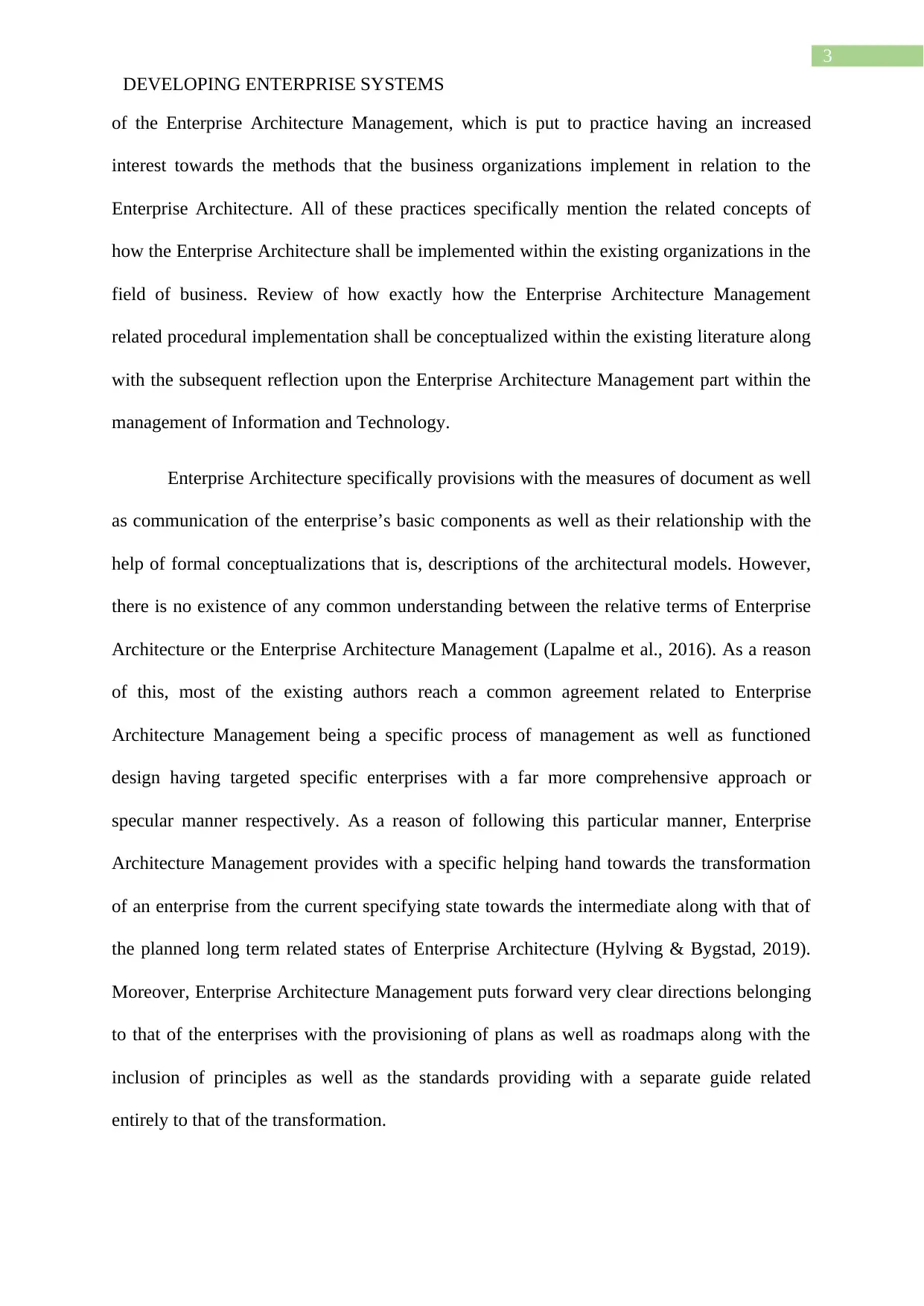
3
DEVELOPING ENTERPRISE SYSTEMS
of the Enterprise Architecture Management, which is put to practice having an increased
interest towards the methods that the business organizations implement in relation to the
Enterprise Architecture. All of these practices specifically mention the related concepts of
how the Enterprise Architecture shall be implemented within the existing organizations in the
field of business. Review of how exactly how the Enterprise Architecture Management
related procedural implementation shall be conceptualized within the existing literature along
with the subsequent reflection upon the Enterprise Architecture Management part within the
management of Information and Technology.
Enterprise Architecture specifically provisions with the measures of document as well
as communication of the enterprise’s basic components as well as their relationship with the
help of formal conceptualizations that is, descriptions of the architectural models. However,
there is no existence of any common understanding between the relative terms of Enterprise
Architecture or the Enterprise Architecture Management (Lapalme et al., 2016). As a reason
of this, most of the existing authors reach a common agreement related to Enterprise
Architecture Management being a specific process of management as well as functioned
design having targeted specific enterprises with a far more comprehensive approach or
specular manner respectively. As a reason of following this particular manner, Enterprise
Architecture Management provides with a specific helping hand towards the transformation
of an enterprise from the current specifying state towards the intermediate along with that of
the planned long term related states of Enterprise Architecture (Hylving & Bygstad, 2019).
Moreover, Enterprise Architecture Management puts forward very clear directions belonging
to that of the enterprises with the provisioning of plans as well as roadmaps along with the
inclusion of principles as well as the standards providing with a separate guide related
entirely to that of the transformation.
DEVELOPING ENTERPRISE SYSTEMS
of the Enterprise Architecture Management, which is put to practice having an increased
interest towards the methods that the business organizations implement in relation to the
Enterprise Architecture. All of these practices specifically mention the related concepts of
how the Enterprise Architecture shall be implemented within the existing organizations in the
field of business. Review of how exactly how the Enterprise Architecture Management
related procedural implementation shall be conceptualized within the existing literature along
with the subsequent reflection upon the Enterprise Architecture Management part within the
management of Information and Technology.
Enterprise Architecture specifically provisions with the measures of document as well
as communication of the enterprise’s basic components as well as their relationship with the
help of formal conceptualizations that is, descriptions of the architectural models. However,
there is no existence of any common understanding between the relative terms of Enterprise
Architecture or the Enterprise Architecture Management (Lapalme et al., 2016). As a reason
of this, most of the existing authors reach a common agreement related to Enterprise
Architecture Management being a specific process of management as well as functioned
design having targeted specific enterprises with a far more comprehensive approach or
specular manner respectively. As a reason of following this particular manner, Enterprise
Architecture Management provides with a specific helping hand towards the transformation
of an enterprise from the current specifying state towards the intermediate along with that of
the planned long term related states of Enterprise Architecture (Hylving & Bygstad, 2019).
Moreover, Enterprise Architecture Management puts forward very clear directions belonging
to that of the enterprises with the provisioning of plans as well as roadmaps along with the
inclusion of principles as well as the standards providing with a separate guide related
entirely to that of the transformation.
Paraphrase This Document
Need a fresh take? Get an instant paraphrase of this document with our AI Paraphraser
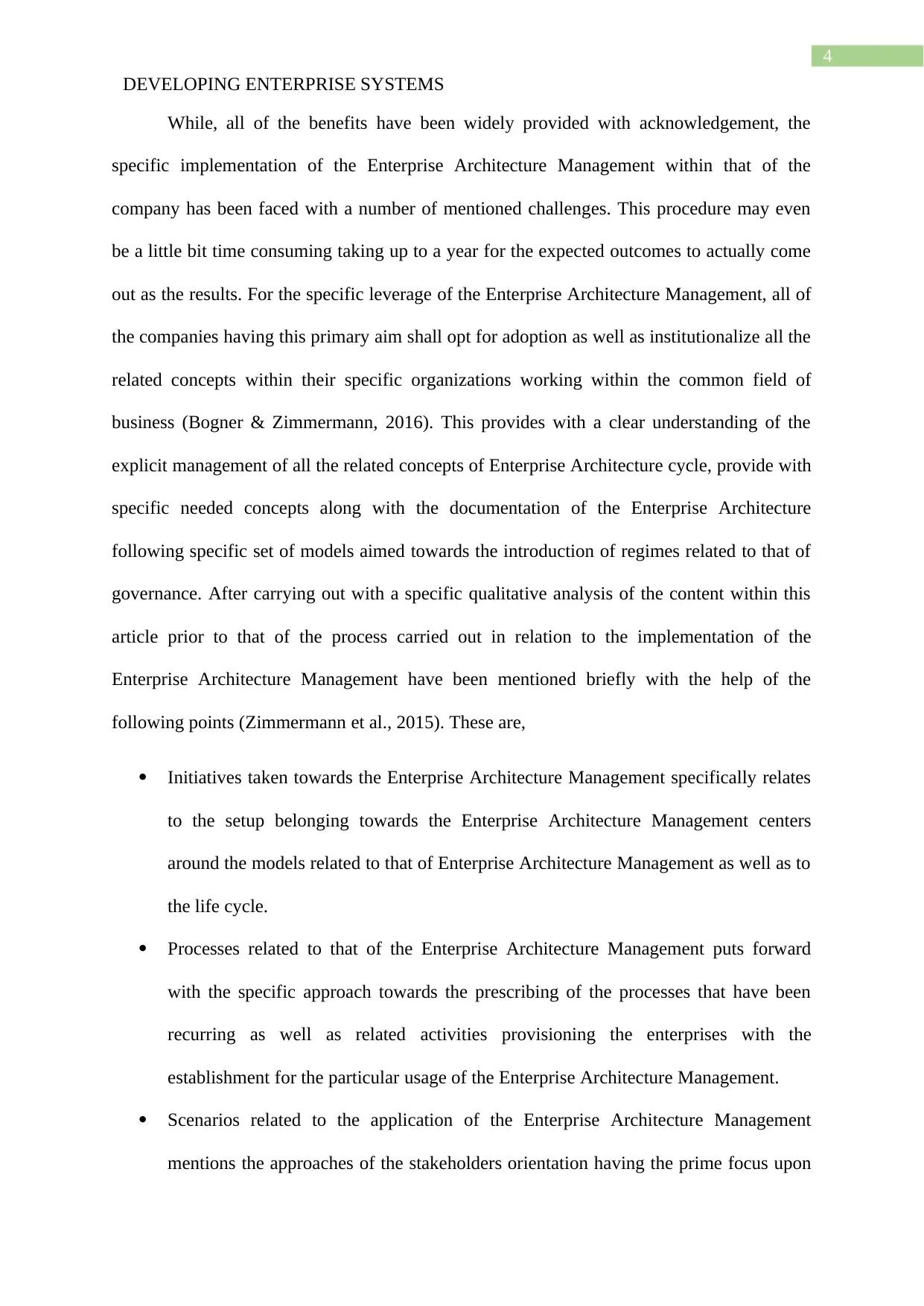
4
DEVELOPING ENTERPRISE SYSTEMS
While, all of the benefits have been widely provided with acknowledgement, the
specific implementation of the Enterprise Architecture Management within that of the
company has been faced with a number of mentioned challenges. This procedure may even
be a little bit time consuming taking up to a year for the expected outcomes to actually come
out as the results. For the specific leverage of the Enterprise Architecture Management, all of
the companies having this primary aim shall opt for adoption as well as institutionalize all the
related concepts within their specific organizations working within the common field of
business (Bogner & Zimmermann, 2016). This provides with a clear understanding of the
explicit management of all the related concepts of Enterprise Architecture cycle, provide with
specific needed concepts along with the documentation of the Enterprise Architecture
following specific set of models aimed towards the introduction of regimes related to that of
governance. After carrying out with a specific qualitative analysis of the content within this
article prior to that of the process carried out in relation to the implementation of the
Enterprise Architecture Management have been mentioned briefly with the help of the
following points (Zimmermann et al., 2015). These are,
Initiatives taken towards the Enterprise Architecture Management specifically relates
to the setup belonging towards the Enterprise Architecture Management centers
around the models related to that of Enterprise Architecture Management as well as to
the life cycle.
Processes related to that of the Enterprise Architecture Management puts forward
with the specific approach towards the prescribing of the processes that have been
recurring as well as related activities provisioning the enterprises with the
establishment for the particular usage of the Enterprise Architecture Management.
Scenarios related to the application of the Enterprise Architecture Management
mentions the approaches of the stakeholders orientation having the prime focus upon
DEVELOPING ENTERPRISE SYSTEMS
While, all of the benefits have been widely provided with acknowledgement, the
specific implementation of the Enterprise Architecture Management within that of the
company has been faced with a number of mentioned challenges. This procedure may even
be a little bit time consuming taking up to a year for the expected outcomes to actually come
out as the results. For the specific leverage of the Enterprise Architecture Management, all of
the companies having this primary aim shall opt for adoption as well as institutionalize all the
related concepts within their specific organizations working within the common field of
business (Bogner & Zimmermann, 2016). This provides with a clear understanding of the
explicit management of all the related concepts of Enterprise Architecture cycle, provide with
specific needed concepts along with the documentation of the Enterprise Architecture
following specific set of models aimed towards the introduction of regimes related to that of
governance. After carrying out with a specific qualitative analysis of the content within this
article prior to that of the process carried out in relation to the implementation of the
Enterprise Architecture Management have been mentioned briefly with the help of the
following points (Zimmermann et al., 2015). These are,
Initiatives taken towards the Enterprise Architecture Management specifically relates
to the setup belonging towards the Enterprise Architecture Management centers
around the models related to that of Enterprise Architecture Management as well as to
the life cycle.
Processes related to that of the Enterprise Architecture Management puts forward
with the specific approach towards the prescribing of the processes that have been
recurring as well as related activities provisioning the enterprises with the
establishment for the particular usage of the Enterprise Architecture Management.
Scenarios related to the application of the Enterprise Architecture Management
mentions the approaches of the stakeholders orientation having the prime focus upon

5
DEVELOPING ENTERPRISE SYSTEMS
the particularly related concerns along with that of all the viewpoints together
alongside.
Governance related to that of the Enterprise Architecture Management provides with
a specific approach towards the process for emphasizing of the roles as well as the
regimes of governance in relation to the Enterprise Architecture Management.
The first and foremost stream related to that of the research consists of the inclusion of all the
established frameworks related to that of the Enterprise Architecture as well as the literature
(Julia, Kurt & Ulf, 2018). This provides with a proposition of the various building blocks
related to that of Enterprise Architecture Management having the strong prime focus upon the
development of architecture as well as the related transition inclusive.
The specific approaches provisions with the particular descriptions of all the recurring
Enterprise Architecture Management related processes as well as the activities. Certain
authors have provided special concentration upon the individual Enterprise Architecture
Management activities, such as the description as well as development of the target state
Enterprise Architecture along with the methods of analysis as well as evaluation (Vanauer,
Böhle & Hellingrath, 2015). Other existing authors provided with a different definition,
which says that, all of the related processes of Enterprise Architecture Management are
present upon the micro or the macro level separately. There are made specific suggestions of
high-level processes related to that of architecture belonging to the strategy of information
and technology. All of these processes include the likes of modeling, portfolio management
related to that of Information and technology application, monitoring of projects,
development of projects as well as the methods of enforcement.
In reference to the third stream of research, special emphasis has been placed upon the
necessary step towards the addressing of the specific stakeholder along with the related
DEVELOPING ENTERPRISE SYSTEMS
the particularly related concerns along with that of all the viewpoints together
alongside.
Governance related to that of the Enterprise Architecture Management provides with
a specific approach towards the process for emphasizing of the roles as well as the
regimes of governance in relation to the Enterprise Architecture Management.
The first and foremost stream related to that of the research consists of the inclusion of all the
established frameworks related to that of the Enterprise Architecture as well as the literature
(Julia, Kurt & Ulf, 2018). This provides with a proposition of the various building blocks
related to that of Enterprise Architecture Management having the strong prime focus upon the
development of architecture as well as the related transition inclusive.
The specific approaches provisions with the particular descriptions of all the recurring
Enterprise Architecture Management related processes as well as the activities. Certain
authors have provided special concentration upon the individual Enterprise Architecture
Management activities, such as the description as well as development of the target state
Enterprise Architecture along with the methods of analysis as well as evaluation (Vanauer,
Böhle & Hellingrath, 2015). Other existing authors provided with a different definition,
which says that, all of the related processes of Enterprise Architecture Management are
present upon the micro or the macro level separately. There are made specific suggestions of
high-level processes related to that of architecture belonging to the strategy of information
and technology. All of these processes include the likes of modeling, portfolio management
related to that of Information and technology application, monitoring of projects,
development of projects as well as the methods of enforcement.
In reference to the third stream of research, special emphasis has been placed upon the
necessary step towards the addressing of the specific stakeholder along with the related
⊘ This is a preview!⊘
Do you want full access?
Subscribe today to unlock all pages.

Trusted by 1+ million students worldwide
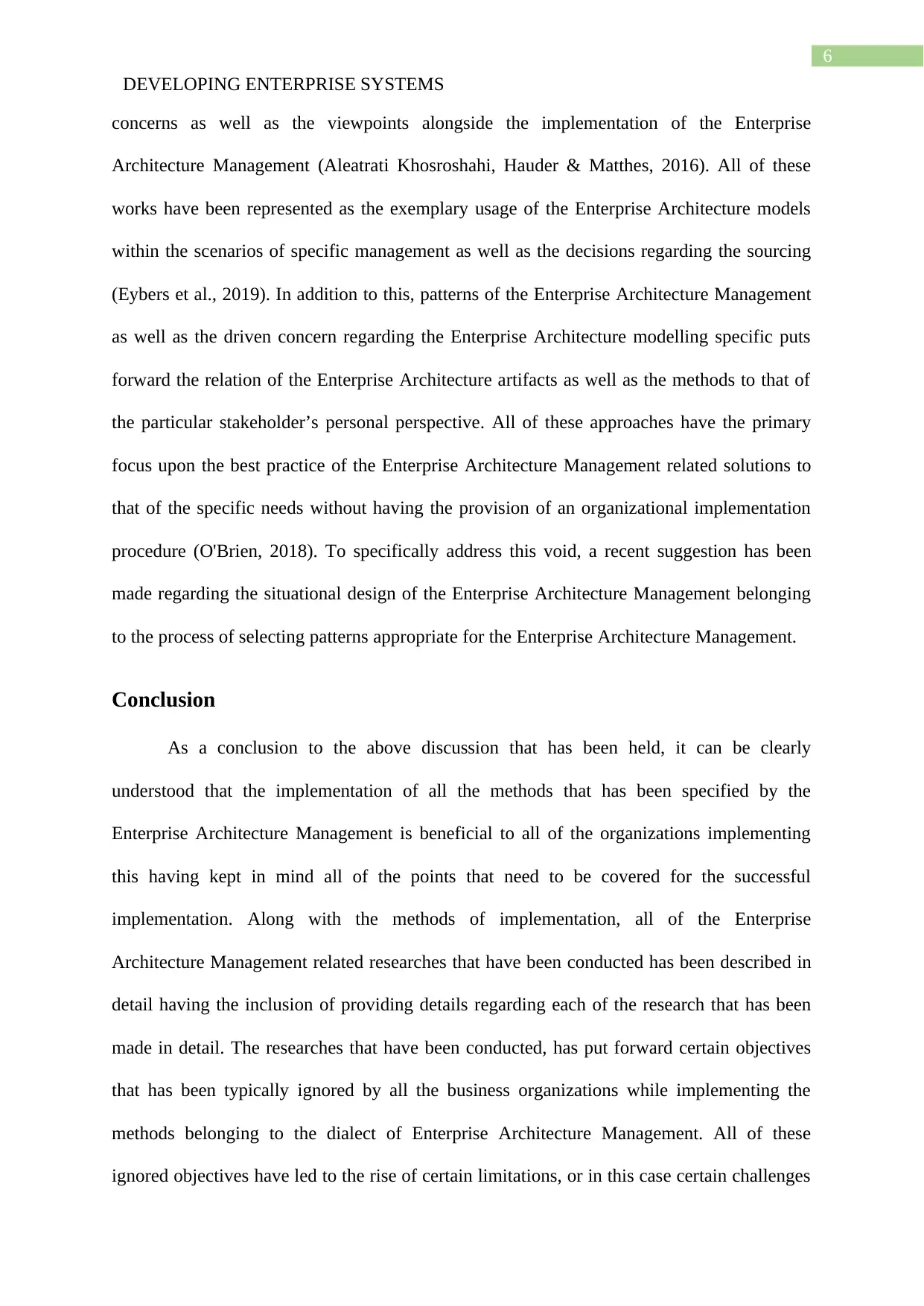
6
DEVELOPING ENTERPRISE SYSTEMS
concerns as well as the viewpoints alongside the implementation of the Enterprise
Architecture Management (Aleatrati Khosroshahi, Hauder & Matthes, 2016). All of these
works have been represented as the exemplary usage of the Enterprise Architecture models
within the scenarios of specific management as well as the decisions regarding the sourcing
(Eybers et al., 2019). In addition to this, patterns of the Enterprise Architecture Management
as well as the driven concern regarding the Enterprise Architecture modelling specific puts
forward the relation of the Enterprise Architecture artifacts as well as the methods to that of
the particular stakeholder’s personal perspective. All of these approaches have the primary
focus upon the best practice of the Enterprise Architecture Management related solutions to
that of the specific needs without having the provision of an organizational implementation
procedure (O'Brien, 2018). To specifically address this void, a recent suggestion has been
made regarding the situational design of the Enterprise Architecture Management belonging
to the process of selecting patterns appropriate for the Enterprise Architecture Management.
Conclusion
As a conclusion to the above discussion that has been held, it can be clearly
understood that the implementation of all the methods that has been specified by the
Enterprise Architecture Management is beneficial to all of the organizations implementing
this having kept in mind all of the points that need to be covered for the successful
implementation. Along with the methods of implementation, all of the Enterprise
Architecture Management related researches that have been conducted has been described in
detail having the inclusion of providing details regarding each of the research that has been
made in detail. The researches that have been conducted, has put forward certain objectives
that has been typically ignored by all the business organizations while implementing the
methods belonging to the dialect of Enterprise Architecture Management. All of these
ignored objectives have led to the rise of certain limitations, or in this case certain challenges
DEVELOPING ENTERPRISE SYSTEMS
concerns as well as the viewpoints alongside the implementation of the Enterprise
Architecture Management (Aleatrati Khosroshahi, Hauder & Matthes, 2016). All of these
works have been represented as the exemplary usage of the Enterprise Architecture models
within the scenarios of specific management as well as the decisions regarding the sourcing
(Eybers et al., 2019). In addition to this, patterns of the Enterprise Architecture Management
as well as the driven concern regarding the Enterprise Architecture modelling specific puts
forward the relation of the Enterprise Architecture artifacts as well as the methods to that of
the particular stakeholder’s personal perspective. All of these approaches have the primary
focus upon the best practice of the Enterprise Architecture Management related solutions to
that of the specific needs without having the provision of an organizational implementation
procedure (O'Brien, 2018). To specifically address this void, a recent suggestion has been
made regarding the situational design of the Enterprise Architecture Management belonging
to the process of selecting patterns appropriate for the Enterprise Architecture Management.
Conclusion
As a conclusion to the above discussion that has been held, it can be clearly
understood that the implementation of all the methods that has been specified by the
Enterprise Architecture Management is beneficial to all of the organizations implementing
this having kept in mind all of the points that need to be covered for the successful
implementation. Along with the methods of implementation, all of the Enterprise
Architecture Management related researches that have been conducted has been described in
detail having the inclusion of providing details regarding each of the research that has been
made in detail. The researches that have been conducted, has put forward certain objectives
that has been typically ignored by all the business organizations while implementing the
methods belonging to the dialect of Enterprise Architecture Management. All of these
ignored objectives have led to the rise of certain limitations, or in this case certain challenges
Paraphrase This Document
Need a fresh take? Get an instant paraphrase of this document with our AI Paraphraser
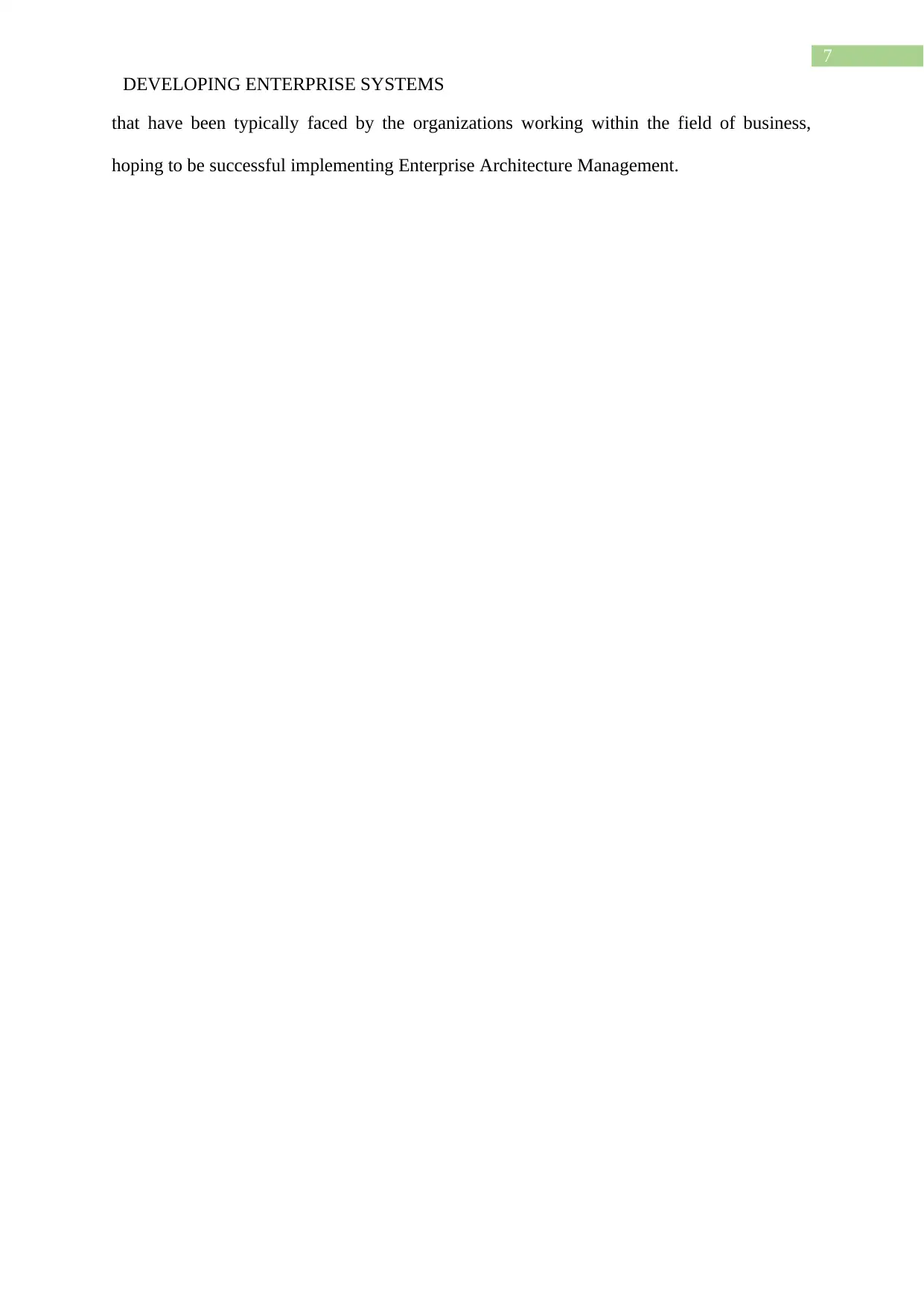
7
DEVELOPING ENTERPRISE SYSTEMS
that have been typically faced by the organizations working within the field of business,
hoping to be successful implementing Enterprise Architecture Management.
DEVELOPING ENTERPRISE SYSTEMS
that have been typically faced by the organizations working within the field of business,
hoping to be successful implementing Enterprise Architecture Management.

8
DEVELOPING ENTERPRISE SYSTEMS
References
Aleatrati Khosroshahi, P., Hauder, M., & Matthes, F. (2016). Analyzing the evolution and
usage of enterprise architecture management patterns.
Bogner, J., & Zimmermann, A. (2016, September). Towards integrating microservices with
adaptable enterprise architecture. In 2016 IEEE 20th International Enterprise
Distributed Object Computing Workshop (EDOCW) (pp. 1-6). IEEE.
Eybers, S., Gerber, A., Bork, D., & Karagiannis, D. (2019). Matching Technology with
Enterprise Architecture and Enterprise Architecture Management Tasks Using Task
Technology Fit. In Enterprise, Business-Process and Information Systems
Modeling (pp. 245-260). Springer, Cham.
Hansen, P., & Hacks, S. (2017). Continuous delivery for enterprise architecture
maintenance. Full-scale Software Engineering/The Art of Software Testing, 56.
Hylving, L., & Bygstad, B. (2019). Nuanced Responses to Enterprise Architecture
Management: Loyalty, Voice, and Exit. Journal of Management Information
Systems, 36(1), 14-36.
Julia, K., Kurt, S., & Ulf, S. (2018). How Digital Transformation affects Enterprise
Architecture Management–a case study. Decision-making to switch your ERP system:
empirical Japanese evidence, 6(3), 5-18.
Lange, M., Mendling, J., & Recker, J. (2016). An empirical analysis of the factors and
measures of Enterprise Architecture Management success. European Journal of
Information Systems, 25(5), 411-431.
DEVELOPING ENTERPRISE SYSTEMS
References
Aleatrati Khosroshahi, P., Hauder, M., & Matthes, F. (2016). Analyzing the evolution and
usage of enterprise architecture management patterns.
Bogner, J., & Zimmermann, A. (2016, September). Towards integrating microservices with
adaptable enterprise architecture. In 2016 IEEE 20th International Enterprise
Distributed Object Computing Workshop (EDOCW) (pp. 1-6). IEEE.
Eybers, S., Gerber, A., Bork, D., & Karagiannis, D. (2019). Matching Technology with
Enterprise Architecture and Enterprise Architecture Management Tasks Using Task
Technology Fit. In Enterprise, Business-Process and Information Systems
Modeling (pp. 245-260). Springer, Cham.
Hansen, P., & Hacks, S. (2017). Continuous delivery for enterprise architecture
maintenance. Full-scale Software Engineering/The Art of Software Testing, 56.
Hylving, L., & Bygstad, B. (2019). Nuanced Responses to Enterprise Architecture
Management: Loyalty, Voice, and Exit. Journal of Management Information
Systems, 36(1), 14-36.
Julia, K., Kurt, S., & Ulf, S. (2018). How Digital Transformation affects Enterprise
Architecture Management–a case study. Decision-making to switch your ERP system:
empirical Japanese evidence, 6(3), 5-18.
Lange, M., Mendling, J., & Recker, J. (2016). An empirical analysis of the factors and
measures of Enterprise Architecture Management success. European Journal of
Information Systems, 25(5), 411-431.
⊘ This is a preview!⊘
Do you want full access?
Subscribe today to unlock all pages.

Trusted by 1+ million students worldwide
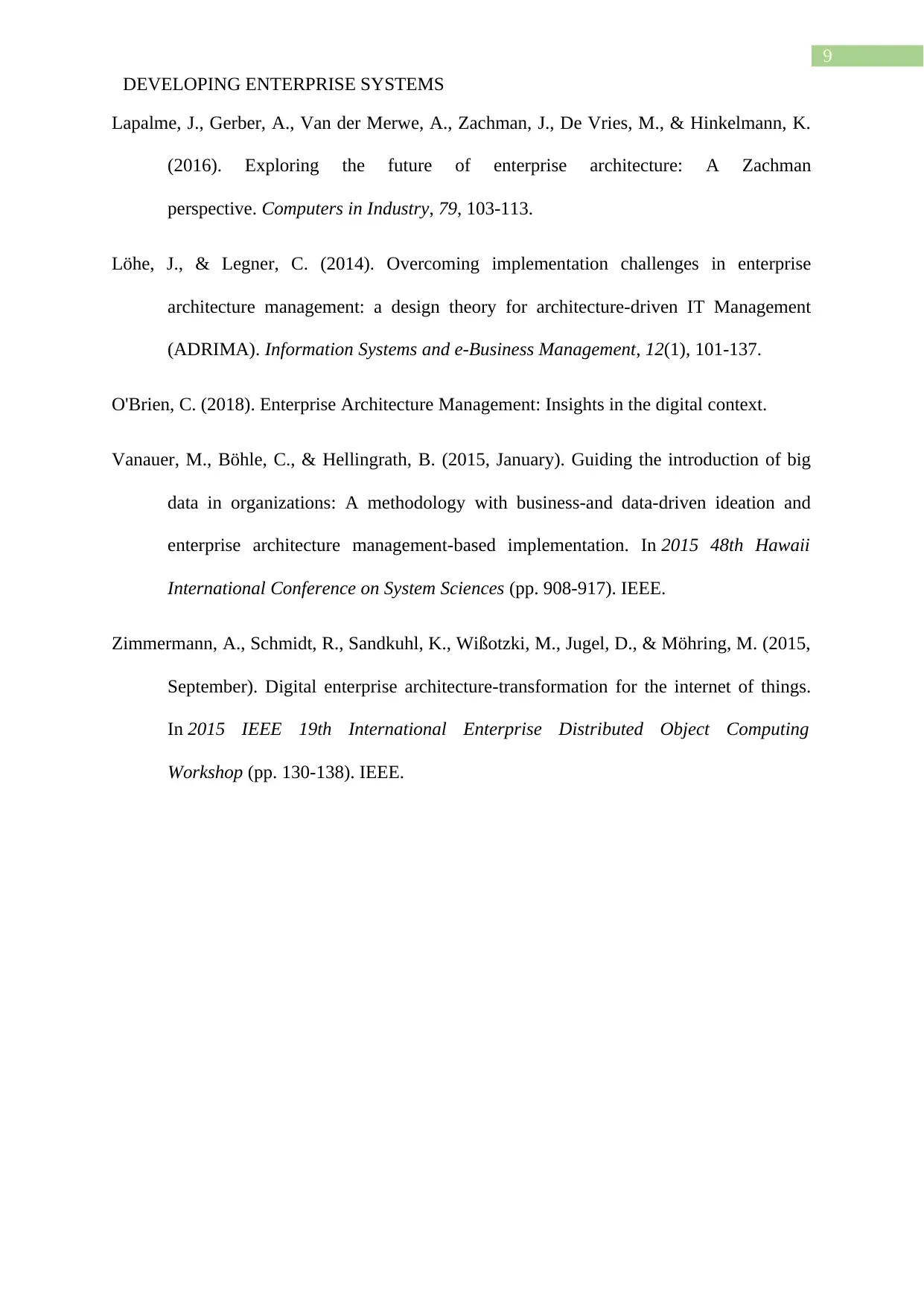
9
DEVELOPING ENTERPRISE SYSTEMS
Lapalme, J., Gerber, A., Van der Merwe, A., Zachman, J., De Vries, M., & Hinkelmann, K.
(2016). Exploring the future of enterprise architecture: A Zachman
perspective. Computers in Industry, 79, 103-113.
Löhe, J., & Legner, C. (2014). Overcoming implementation challenges in enterprise
architecture management: a design theory for architecture-driven IT Management
(ADRIMA). Information Systems and e-Business Management, 12(1), 101-137.
O'Brien, C. (2018). Enterprise Architecture Management: Insights in the digital context.
Vanauer, M., Böhle, C., & Hellingrath, B. (2015, January). Guiding the introduction of big
data in organizations: A methodology with business-and data-driven ideation and
enterprise architecture management-based implementation. In 2015 48th Hawaii
International Conference on System Sciences (pp. 908-917). IEEE.
Zimmermann, A., Schmidt, R., Sandkuhl, K., Wißotzki, M., Jugel, D., & Möhring, M. (2015,
September). Digital enterprise architecture-transformation for the internet of things.
In 2015 IEEE 19th International Enterprise Distributed Object Computing
Workshop (pp. 130-138). IEEE.
DEVELOPING ENTERPRISE SYSTEMS
Lapalme, J., Gerber, A., Van der Merwe, A., Zachman, J., De Vries, M., & Hinkelmann, K.
(2016). Exploring the future of enterprise architecture: A Zachman
perspective. Computers in Industry, 79, 103-113.
Löhe, J., & Legner, C. (2014). Overcoming implementation challenges in enterprise
architecture management: a design theory for architecture-driven IT Management
(ADRIMA). Information Systems and e-Business Management, 12(1), 101-137.
O'Brien, C. (2018). Enterprise Architecture Management: Insights in the digital context.
Vanauer, M., Böhle, C., & Hellingrath, B. (2015, January). Guiding the introduction of big
data in organizations: A methodology with business-and data-driven ideation and
enterprise architecture management-based implementation. In 2015 48th Hawaii
International Conference on System Sciences (pp. 908-917). IEEE.
Zimmermann, A., Schmidt, R., Sandkuhl, K., Wißotzki, M., Jugel, D., & Möhring, M. (2015,
September). Digital enterprise architecture-transformation for the internet of things.
In 2015 IEEE 19th International Enterprise Distributed Object Computing
Workshop (pp. 130-138). IEEE.
1 out of 10
Related Documents
Your All-in-One AI-Powered Toolkit for Academic Success.
+13062052269
info@desklib.com
Available 24*7 on WhatsApp / Email
![[object Object]](/_next/static/media/star-bottom.7253800d.svg)
Unlock your academic potential
Copyright © 2020–2025 A2Z Services. All Rights Reserved. Developed and managed by ZUCOL.





